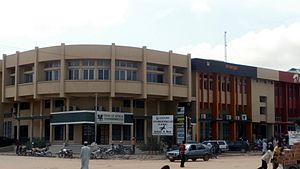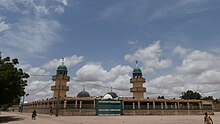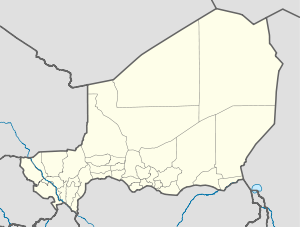Maradi, Niger
Maradi | |
|---|---|
 A street in Maradi, Niger | |
| Coordinates: 13°29′30″N 7°5′47″E / 13.49167°N 7.09639°E | |
| Country | |
| Region | Maradi Region |
| Department | Maradi Department |
| Urban Commune | Maradi |
| Government | |
| • Type | Seat of Departmental and Regional councils, Urban Commune |
| Area | |
| • Land | 74 km2 (28.6 sq mi) |
| Elevation | 385 m (1,259 ft) |
| Population (2012) | |
• Total | 267,249 |
| • Summer (DST) | UTC+1 |
Maradi is the second largest city in Niger and the administrative centre of Maradi Region. It is also the seat of the Maradi Department and an Urban Commune.
History
Originally part of Katsina, a Hausa state, it became independent in the 19th century.[1] From the early 19th century, Maradi was home to one of several Hausa traditional rump states, formed by rulers and nobility who fled the rise of the Sokoto Caliphate.[2] Elements of the Katsina ruling class continued to claim the area as the seat of a Katsina state in exile ruled by the Sarkin Katsina Maradi. Maradi was constrained by the more powerful Gobir exilic state to the west, the Sultanate of Damagaram based at Zinder to the east, and Sokoto to the south. The arrival of the French in 1899 saw the bloody destruction of the town by the Voulet–Chanoine Mission, but later the town recovered to become an important regional centre of commerce by the 1950s.
The expansion of the city in the first half of the 20th century was dynamic, albeit modest, with the population nearly doubling between 1911 and 1950.[3] Up until 1945, the ancient city of Maradi was located in the valley bordering the Goulbi N'Maradi, a seasonal waterway with its source in Nigeria. The urban area, roughly circular in shape, was protected by a mud wall with four doors; the ancient city was flooded by this river at the end of the rainy season of 1945. To avoid future inundation, the French colonial administration decided then to adjust the urban layout. In the process, the city lost its traditional, irregular layout in favour of a grid system.[3] The French sought to create cash-crop agriculture, mostly groundnuts, which increasingly made the city an important regional commercial centre. Aided by economic growth after the 1950s, Maradi experienced a demographic boom, with the population increasing from 8,661 in 1950 to 80,000 by 1983.[3] By the time of Niger's independence in 1960, Maradi was a centre of Hausa culture, vying with the larger traditional Hausa centre of Zinder to the east.
In 2000 a riot broke out in the town by Muslim groups opposed to the staging of the Festival International de la Mode en Afrique (FIMA) in Niamey, resulting in the destruction of various buildings deemed un-Islamic, such as brothels and bars.[2][4]
Geography
The city is divided into three urban municipalities: Maradi I, Maradi II and Maradi III. Maradi is centred on the Grand-marché, a large daily market of wholesale, retail, and agricultural goods from across south central Niger and also the cross-border trade with Nigeria.[5] Some of the districts in the town include Zaria and Sabon Gari in the north, and to the west Mokoya, Dan Gouleye, Bagalam, Yandaka, Maradawa, Hassao and Limantchi.[2]
Climate
Maradi experiences oppressive, mostly cloudy wet seasons, windy, partly cloudy dry seasons, and hot temperatures all year long ranging from 58°F to 104°F, rarely falling below 53°F or above 107°F.[6][7][8][9][10]
| Climate data for Maradi Airport (1961–1990) | |||||||||||||
|---|---|---|---|---|---|---|---|---|---|---|---|---|---|
| Month | Jan | Feb | Mar | Apr | May | Jun | Jul | Aug | Sep | Oct | Nov | Dec | Year |
| Mean maximum °C (°F) | 35.0 (95.0) |
38.3 (100.9) |
41.3 (106.3) |
42.9 (109.2) |
42.4 (108.3) |
40.8 (105.4) |
36.9 (98.4) |
34.9 (94.8) |
37.3 (99.1) |
38.6 (101.5) |
37.3 (99.1) |
35.6 (96.1) |
42.9 (109.2) |
| Mean daily maximum °C (°F) | 30.2 (86.4) |
33.6 (92.5) |
37.0 (98.6) |
40.0 (104.0) |
39.7 (103.5) |
37.0 (98.6) |
33.2 (91.8) |
31.7 (89.1) |
33.8 (92.8) |
36.3 (97.3) |
33.9 (93.0) |
31.1 (88.0) |
34.8 (94.6) |
| Daily mean °C (°F) | 21.6 (70.9) |
24.6 (76.3) |
28.4 (83.1) |
32.0 (89.6) |
32.7 (90.9) |
31.0 (87.8) |
28.2 (82.8) |
27.0 (80.6) |
28.2 (82.8) |
28.4 (83.1) |
25.2 (77.4) |
22.3 (72.1) |
27.4 (81.3) |
| Mean daily minimum °C (°F) | 13.0 (55.4) |
15.6 (60.1) |
19.8 (67.6) |
24.0 (75.2) |
25.7 (78.3) |
25.0 (77.0) |
23.2 (73.8) |
22.2 (72.0) |
22.5 (72.5) |
20.5 (68.9) |
16.5 (61.7) |
13.5 (56.3) |
20.1 (68.2) |
| Mean minimum °C (°F) | 8.8 (47.8) |
11.4 (52.5) |
14.5 (58.1) |
18.5 (65.3) |
20.9 (69.6) |
20.1 (68.2) |
19.5 (67.1) |
19.2 (66.6) |
19.1 (66.4) |
16.3 (61.3) |
12.1 (53.8) |
9.5 (49.1) |
8.8 (47.8) |
| Average precipitation mm (inches) | 0.0 (0.0) |
0.0 (0.0) |
0.3 (0.01) |
4.1 (0.16) |
18.9 (0.74) |
63.5 (2.50) |
149.0 (5.87) |
175.1 (6.89) |
74.9 (2.95) |
6.6 (0.26) |
0.0 (0.0) |
0.0 (0.0) |
491.3 (19.34) |
| Mean monthly sunshine hours | 282.1 | 263.2 | 269.7 | 261.0 | 291.4 | 279.0 | 257.3 | 235.6 | 255.0 | 285.2 | 282.0 | 279.0 | 3,248.5 |
| Mean daily sunshine hours | 9.1 | 9.4 | 8.7 | 8.7 | 9.4 | 9.3 | 8.3 | 7.6 | 8.5 | 9.2 | 9.4 | 9.0 | 8.9 |
| Source: NOAA[11] | |||||||||||||
Demographics
| Year | Population (Census)[12] |
|---|---|
| 1977 | 44,458 |
| 1988 | 110,005 |
| 2001 | 148,017 |
| 2012 | 267,249 |
At the 2012 census, the official population of Maradi was 267,249, making it the second largest city in the country,[13] with the predominant ethnic group in the city being Hausa, with a few urbanised Fulani and Tuaregs living there as well. Various ethnic groups from Nigeria, particularly Ibo and Yoruba, can also be found in skilled trades or in small shops.[citation needed]
Places of worship

There are several large mosques in the town. There are also some Christian churches and temples, with the Roman Catholic Diocese of Maradi, Our Lady of Lourdes Cathedral, various Protestant churches and the Assemblies of God having a presence.[14]
Economy
Maradi is the major transport trade and agricultural hub of Niger's south central Hausa region.[15] It lies on the major east–west paved highway which crosses from Niamey in the west to Diffa in the far east. It also has an airport. Maradi has long been a merchant city, on the route north from Kano, Nigeria. This explains why one can use either the West African CFA franc (Niger's official currency) or the Nigerian Naira for currency in Maradi.[citation needed] The city lies in a region known for groundnut cultivation.
Education
- Dan Dicko Dankoulodo University of Maradi, UDDM (2008)[16]
- Institut Universitaire de Technologie IUT

The Free University of Maradi was founded in 2004.[citation needed] There is a Maryam Abacha American University Niger located in the city of Maradi.
Culture
Notable people
- Siradji Sani, Nigerien footballer
- Mariama Gamatié Bayard, 2011 presidential candidate
Gallery
- Regional government building
- Street scene in Maradi
- A mosque in Maradi
- Worshippers at the Tchana Mosque
- Traditional-style Hausa architecture buildings
References
- ^ Abdourahmane Idrissa, Samuel Decalo, Historical Dictionary of Niger, Scarecrow Press, USA, 2012, p. 316
- ^ a b c Geels, Jolijn, (2006) Bradt Travel Guide – Niger, pgs. 203–212
- ^ a b c Les alhazai de Maradi – l’histoire d’une groupe de riche marchands saheliens. Emmanuel Gregoire. Éditions de I'ORSTOM. 1990.
- ^ Saidou Arji; Noel Tadegnon (15 November 2000). "NCULTURE-NIGER: Government to Ban Islamic Groups Opposed to Fashion Festival". Retrieved 29 October 2019.
- ^ Information on Maradi grand-marché Archived 27 July 2011 at the Wayback Machine. RESIMAO West-African Market Information Network. Price Statistics from the official West African Market Price Agencies -online
- ^ "Maradi Climate, Weather By Month, Average Temperature (Niger) - Weather Spark". weatherspark.com. Retrieved 22 September 2023.
- ^ "Maradi, NE Climate Zone, Monthly Weather Averages and Historical Data". tcktcktck.org. Retrieved 22 September 2023.
- ^ "Maradi climate: weather by month, temperature, rain - Climates to Travel". www.climatestotravel.com. Retrieved 22 September 2023.
- ^ "Simulated historical climate & weather data for Maradi". meteoblue. Retrieved 22 September 2023.
- ^ "Climate & Weather Averages in Maradi, Niger". www.timeanddate.com. Retrieved 22 September 2023.
- ^ "Station Name: MARADI AERO" (TXT). National Oceanic and Atmospheric Administration. Retrieved 24 August 2024.
- ^ "Niger: Regions, Cities & Urban Centers - Population Statistics, Maps, Charts, Weather and Web Information". www.citypopulation.de. Retrieved 28 May 2021.
- ^ "Niger: Regions, Cities & Urban Centers – Population Statistics, Maps, Charts, Weather and Web Information". citypopulation.de. Retrieved 23 March 2019.
- ^ J. Gordon Melton, Martin Baumann, ‘‘Religions of the World: A Comprehensive Encyclopedia of Beliefs and Practices’’, ABC-CLIO, USA, 2010, p. 2103
- ^ Britannica, Maradi, britannica.com, USA, accessed on July 7, 2019
- ^ Law No. 2014-49 of 16 October 2014
- Finn Fuglestad. A History of Niger: 1850–1960. Cambridge University Press (1983) ISBN 0-521-25268-7
- Jolijn Geels. Niger. Bradt UK/ Globe Pequot Press USA (2006) ISBN 978-1-84162-152-4
- Samuel Decalo. Historical Dictionary of Niger (3rd ed.). Scarecrow Press, Boston & Folkestone, (1997) ISBN 0-8108-3136-8
- Derrick J. Thorn. "The City of Maradi: French Influence Upon a Hausa Urban Center". Journal of Geography, Volume 70, Issue 8 November 1971, pages 472 – 482
External links
 Maradi travel guide from Wikivoyage
Maradi travel guide from Wikivoyage






